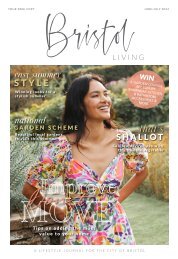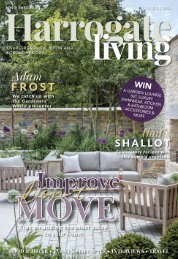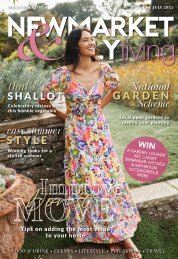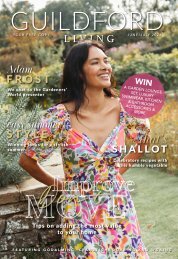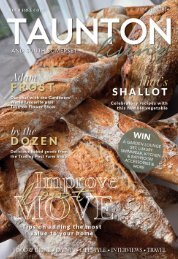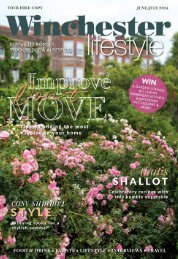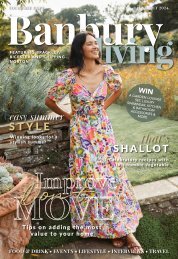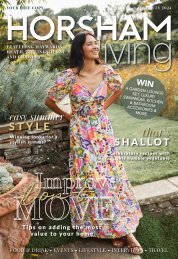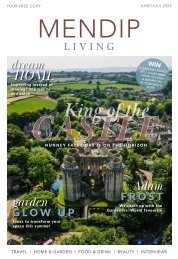Leamington and Warwick Living Jul - Aug 2023
The summer is here - with bountiful produce, longer days and uplifting sunshine! We've echoed that with this edition, with lots of home, garden and foodie inspiration. Plus, check out our bumper competition guide, with garden goodies, skincare sets and hotel stays to be won!
The summer is here - with bountiful produce, longer days and uplifting sunshine! We've echoed that with this edition, with lots of home, garden and foodie inspiration. Plus, check out our bumper competition guide, with garden goodies, skincare sets and hotel stays to be won!
You also want an ePaper? Increase the reach of your titles
YUMPU automatically turns print PDFs into web optimized ePapers that Google loves.
SAVE THE BEES<br />
THE BEST POLLINATOR PLANTS<br />
The team at the UK’s largest-family run group, British<br />
Garden Centres look at the 10 best plants that grow<br />
easily <strong>and</strong> attract pollinators in your garden from early<br />
spring to summer...<br />
LAVENDER - Bees’ favourite during the summer months is<br />
lavender. It is known for its wonderful scent <strong>and</strong> pollinating<br />
insects that draw nectar from its dark purple flowers. Lavender is<br />
a durable <strong>and</strong> highly versatile perennial herb that can be used in<br />
borders <strong>and</strong> containers to form fragrant bushes.<br />
FOXGLOVES - Plants like foxglove have magnificent spikes of<br />
purple, pink, white <strong>and</strong> blue flowers. The flowers of this cottage<br />
garden classic attract solitary bees, <strong>and</strong> it thrives in light shade<br />
with well-drained soil. Native to Britain, foxgloves are perfect for<br />
wildlife gardens <strong>and</strong> can be used as cut flowers.<br />
WILDFLOWERS - You can buy wildflower mixes in your local<br />
British Garden Centres, which will bring the buzz to your garden.<br />
This type of planting requires little maintenance <strong>and</strong> will help<br />
feed Britain’s bees by creating urban wildflower meadows in your<br />
backyard. They are a fantastic habitat, food source <strong>and</strong> pollinator<br />
for bees, birds, butterflies <strong>and</strong> insects.<br />
POPPIES - Poppies are an excellent pollen source with their<br />
open petals inviting pollinators to feast on nectar. Your outdoor<br />
space will be filled with bursts of red, white, purple, pink <strong>and</strong> blue<br />
flowers that entice insects. Poppies thrive in good sunlight <strong>and</strong><br />
loose soil conditions.<br />
VERBENA - Verbena with its round clusters of bright, lilac<br />
flowers is a favourite with both bees <strong>and</strong> butterflies. An<br />
outst<strong>and</strong>ing addition to the back of a summer border, the high<br />
stems attract pollinators who take turns to feast all over the year,<br />
because of its extended flowering period.<br />
DAHLIAS - There is no better late nectar source for pollinators<br />
than dahlias. Most nectar will come from single-flowered flower<br />
bulbs or tubers with noticeable stamens. Bees <strong>and</strong> butterflies<br />
are attracted to these beautiful flowers, which bloom throughout<br />
summer <strong>and</strong> early autumn.<br />
ROSEMARY - Rosemary has extremely fragrant leaves <strong>and</strong><br />
is prized for its cooking <strong>and</strong> medicinal uses, but did you know<br />
it’s helpful to pollinators too? Bees’ affection for the scent <strong>and</strong><br />
nectar-rich flowers brings them in large numbers to forage the<br />
nectar which they can take back to the hive to make honey.<br />
For more great gardening tips, visit:<br />
www.britishgardencentres.com<br />
<br />
<br />
<br />
<br />
<br />
<br />
<br />
<br />
<br />
<br />
<br />
38 | www.minervamagazines.co.uk






